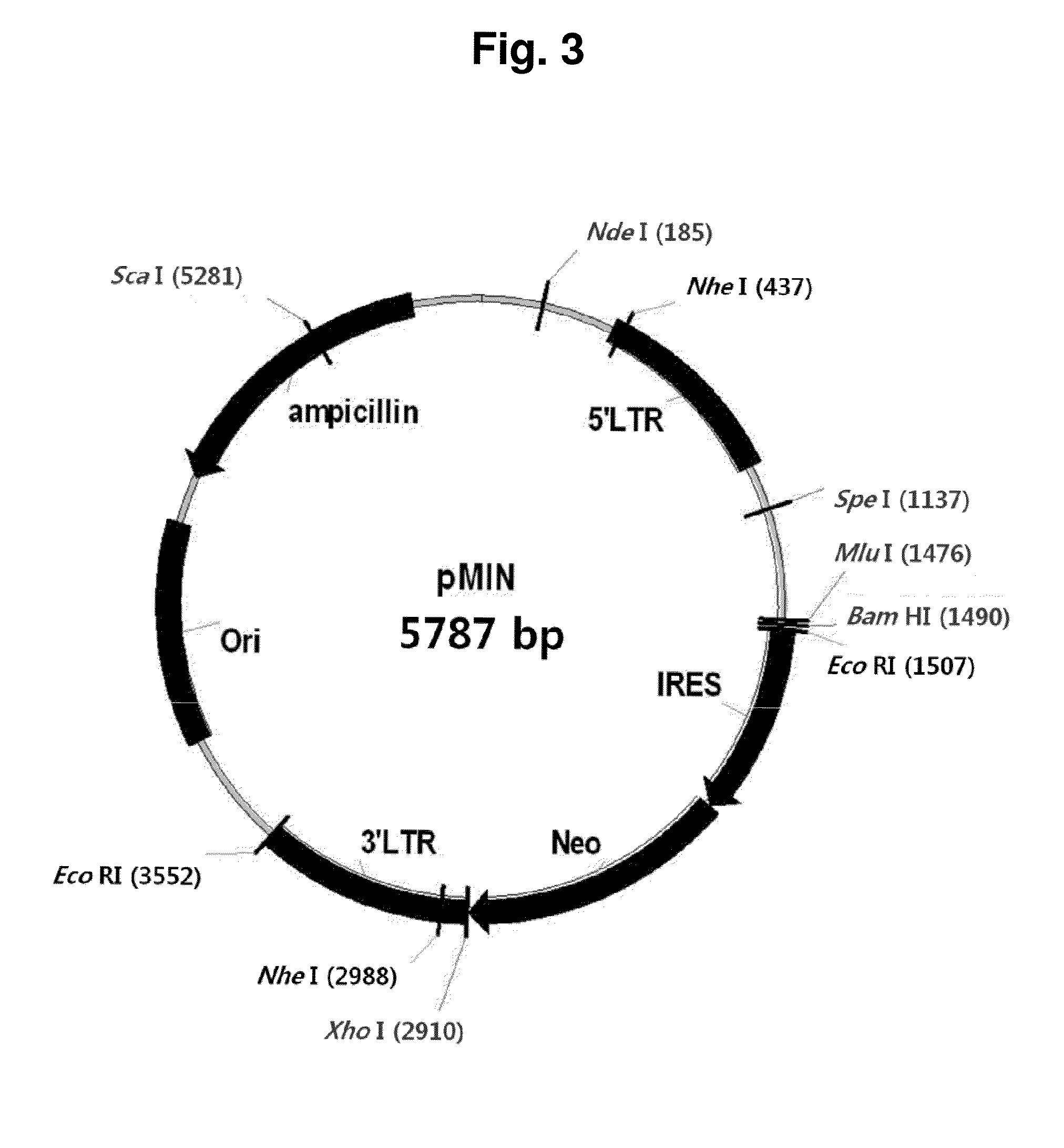Adenovirus producing novel cell line and the use thereof
a technology of adenovirus and cell line, which is applied in the direction of dsdna viruses, fused cells, drug compositions, etc., can solve the problems of inability to control administration, inability to produce replication-competent adenoviruses (rca), and one drawback of adenoviruses, so as to reduce the possibility of replication-competent adenovirus (rca) production, the possibility of rca production is significantly reduced
- Summary
- Abstract
- Description
- Claims
- Application Information
AI Technical Summary
Benefits of technology
Problems solved by technology
Method used
Image
Examples
example 1
Construction of E1 Gene-Expressing Retroviral Vector
[0127]1-1. Preparation of pGemT-E1 Vector
[0128]For the supply of the adenovirus E1 gene sequence, the E1 gene region of the wild-type adenovirus type 5 (Ad5) DNA, corresponding to nucleotides 560-3509, was amplified by PCR using primers of SEQ ID NO: 1 (E1-F primer, Table 1) and SEQ ID NO: 2 (E1-R primer, Table 1). Here, since the primer bound to the 5′-region of the wild-type Ad5 DNA has the sequence of Mlu I restriction enzyme and the primer bound to the 3′-region of the wild-type Ad5 DNA has the sequence of BamH I restriction enzyme, the amplified PCR product has the sequence of Mlu I-E1-BamH I. The amplified PCR product was confirmed to be identical to the origin through sequencing, and then used for the follow-up procedure. The PCR product was ligated into the pGemT easy vector (Promega, Wis., USA) having poly T sequences at both ends of the linear DNA, thereby obtaining the structure pGemT-E1 (FIG. 1).
[0129]
TABLE 1Sequence in...
example 2
Preparation of Adenovirus E1 Gene-Expressing Adenovirus Producing Cell Line
[0140]2-1. Cell Line and Cell Culture
[0141]Cell lines used in the present invention were a total of three: A549 human bronchogenic carcinoma cell line (CCL-185; ATCC, MD, USA), human embryonic retinoblast (CRL-2302; ATCC, MD, USA), and human HeLa cervical carcinoma cell line (CCL-2; ATCC, MD, USA). These cells were cultured in Dulbecco's Modified Eagle's medium (DMEM) supplemented with 10% fetal bovine serum and antibiotics at 37° C. under 5% CO2. The cell culture medium, reagent, and serum were purchased from Gibco (Gibco BRL life technologies, inc., MD, USA), and plastic products for culture were purchased from BD Falcon (BD Falcon, N.J., USA).
[0142]2-2. Selection of Adenovirus Producing Cell Lines Through Comparison of Recombinant Adenovirus Production Capacity Among Cell Lines
[0143]For the selection of a cell line exhibiting the highest capacity in recombinant adenovirus production among three candidate c...
example 3
Characterization of H2C16 Clone
[0148]3-1. PCR Analysis of H2C16 Clone
[0149]When the gene is delivered using the retroviral vector, the retroviral vector including the gene is inserted in the cellular genome DNA. For the confirmation whether the retroviral vector used to produce the H2C16 clone and the Ad-E1 gene were inserted into the cellular genome DNA in a correct structure, MIN-E1 retroviral vector-specific primers of SEQ ID NO: 7-12 (MIN-E1 #1 to 7 primers, Table 1) were designed to amplify DNA bands by the PCR method, and structures thereof were evaluated through sequencing. First, the genome DNA was extracted from the H2C16 clone using a genome DNA extraction kit (Qiagen, Calif., USA). After that, PCR reaction was induced by using the extracted genome DNA as a template and combining respective specific primer sets. It was confirmed that the sizes of the bands amplified on the gel were identical to the expected band sizes through comparison and the MIN-E1 retroviral vector was...
PUM
| Property | Measurement | Unit |
|---|---|---|
| size | aaaaa | aaaaa |
| diameter | aaaaa | aaaaa |
| pH | aaaaa | aaaaa |
Abstract
Description
Claims
Application Information
 Login to View More
Login to View More - R&D
- Intellectual Property
- Life Sciences
- Materials
- Tech Scout
- Unparalleled Data Quality
- Higher Quality Content
- 60% Fewer Hallucinations
Browse by: Latest US Patents, China's latest patents, Technical Efficacy Thesaurus, Application Domain, Technology Topic, Popular Technical Reports.
© 2025 PatSnap. All rights reserved.Legal|Privacy policy|Modern Slavery Act Transparency Statement|Sitemap|About US| Contact US: help@patsnap.com



